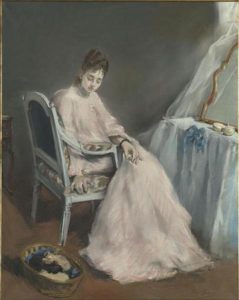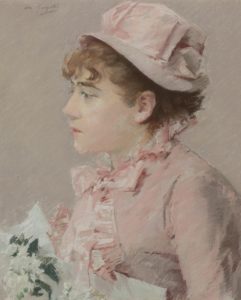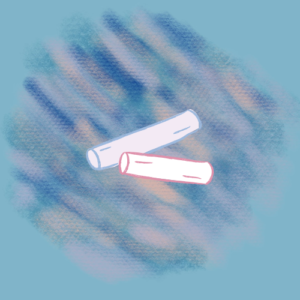As her artistic career progressed, Gonzalès earned increasing praise and recognition for her works. At the beginning of her career in the early 1870s, when her practice was relatively restricted, she received critical reviews dismissing her work with disdainful language rooted in gendered tropes. As her technique matured and she engaged with the Impressionist vanguard, critics began focusing on her technical skill, thereby legitimizing her professional ambitions —but, they continued to view her art through a gendered lens in ways that reviews of her pastel works make particularly evident. The use of gendered language in these reviews is essential to understanding Gonzalès’s praxis and her choice of pastel as a medium.
La Passante received favorable critical reviews, but assessments of this work make clear that critics linked Gonzalès’s gender to her adoption of the pastel medium.[52] As critic Thomas Grimm wrote:
As for La Passante, by Miss Eva Gonzalès, it is an exquisite little canvas […] real, modern which feels nothing like the pastiche of the Flemish, the Italians, or Meissonier. Do you remember the time when pastel flourished? Was it not a charming genre, illustrated by Chardin and Rosalba Carriera? Well!… How many women ugly and aged by photography regretted this elegant pastel which animated with a smiling grace the most vulgar beauties! Well! The pastel pencil portrait of Miss J.C., by Miss Eva Gonzalès triumphs over both genres. [53]

Figure 12. Eva Gonzalès, La Nichée. 1874. Pastel on paper mounted on canvas. 93.8 x 74.3 cm. Musée d’Orsay, Paris, France.
This review combines high praise with charged gendered language. Grimm describes the work as both exquisite and little, emphasizing the appropriateness of its small size for a female artist. The comparison to Carriera is particularly important because Carriera was a woman, recognized for her velvety-smooth and refined pastel technique. Thus, Gonzalès’s work was deemed feminine in two key respects. In referencing both Carriera and Chardin, the critic also directly aligned her pastel with the art of the Rococo era at an early stage in its late nineteenth-century revival.
La Nichée (1874; Fig 12), which moved toward a more abstract, Impressionist rendering, received generally high critical praise. Jules Castagnary, art critic for the newspaper Le Siècle and a well-known supporter of the Impressionists, wrote this review about Gonzalès’s work:
A young girl in a pink peignoir sits in front of her toilet and watches a litter of small dogs crawling in a basket on the floor. It is fair, luminous and a totally seductive harmony. Ms. Eva Gonzalès has an education of a colorist, you can see that right away. She also has a distinguished feeling for the things she puts in each of her productions. Nothing common nor mannered: grace itself in its simplicity and naturalness. These are happy qualities that are bound to lead to the best results. [54]
Like Grimm, Castagnary used stereotypically feminine adjectives to describe this work, such as “grace.” Rather than praising Gonzalès for her artistry, though, he deemed the work’s best qualities to be simple and natural, produced by her “feeling” rather than her intellect. He also noted early on the pink hue that predominates the work, and evoked the association of color with sensuality in his designation of it as “seductive.” Finally, he stressed the level of decorum she achieved, declaring that the work contained nothing “vulgar.” Another review of the same work, by Francis Aubert, made similar points:
A pretty pastel of Miss Eva Gonzalès, La Nichée, a young woman in a pink peignoir, sitting in front of her chambray and lace toilet, looks at two little newborn puppies in a basket: it is cheerful in tone and removed from execution. Ms. Gonzalès, of whom we have seen singularly strong oil paintings, at least in parts, is talented and will certainly have a lot of it if she is willing to free herself a little from some of the influence that prevents her personality from developing freely. [55]
Once again, we see Gonzalès’s work described with adjectives that bear feminine connotations, such as “pretty” and “cheerful.” Importantly, while Aubert compliments Gonzalès, he sees her work as derivative, pointing implicitly to the influence of Manet on her style.[56]

Figure 15. Eva Gonzalès, La Demoiselle d’Honneur. 1879. Pastel on canvas. 45 x 37 cm. Private Collection.
In the 1880s, Gonzalès continued to garner praise and recognition for her pastels. The following review by Eugène Véron examined La Demoiselle d’Honneur (1879; Fig. 7), a work that was exhibited at the Paris Salon of 1880:
Mme. Eva Gonzalès is not only a colorist of rare distinction; she also suggests there is a well-accentuated design under the envelope and by the breadth and great sureness of the model. This is the way of pedigreed artists, and this is why this very seductive pastel is better than a charming work. This exquisite art, so eminently French pastel, Eva Gonzalès brought it back to life by drawing more inspiration from the graduated traditions of the Latour and Perronneau than from the graces of the Rosalba. [57]
The work in question comes from the more “Impressionistic” phase of Gonzalès’s career, yet Véron did not relate its style to that group. Instead, like many other critics before him, he compared her pastels to precedents of the Rococo era. Importantly, in line with the nationalistic aims of the Rococo revival of the 1880s, he declared her “exquisite,” “seductive,” “charming” style to be “eminently French.” But in order to elevate her art this way, Véron aligned her with male “masters” of pastel from the Rococo period—de la Tour and Perroneau—and denied any similarities with the style of Carriera. Additionally, Véron praised her skill in drawing or design, a stereotypically “masculine” achievement, as well as her successful treatment of color. Véron thereby insinuated that Gonzalès was an artist of great intellect, endowing her with “masculine” bona fides, while still approving her conformity to gender decorum.
Eva Gonzalès’s works in pastel therefore helped her secure favorable recognition as a respected artist. Her use of the medium allowed her to connect with the history and tradition of the French Rococo while also employing experimental, avant-garde techniques. We can see in her reception how successfully she navigated the expectations placed on women artists, but also the limitations that she faced: her adoption of vanguard techniques went almost totally unrecognized by the critics of the day.
As this capstone shows, pastel was a tool that Eva Gonzalès utilized strategically to craft her artistic identity within the existing parameters for women artists of the late nineteenth century. Notable within the tradition of French art, and deemed an appropriately feminine medium, pastel enabled her alignment with artists of the Impressionist movement, such as Degas, Monet, and Renoir who, like her, were using it in experimental ways. Her experimentation with the medium has yet to be fully recognized, as it has been shrouded in the gendered language employed by the critics discussed above. This capstone aims to begin a new conversation about Gonzalès’s work by demonstrating how, in her pastels, she negotiated the complex expectations placed on female artists in the late nineteenth century.
52. La Passante (The Bystander; 1870), was exhibited at Gonzalès’ debut at the Paris Salon of 1870. The work was lost and no images of the work exist.
53. Thomas Grimm, “Le Clan des Femmes Peintres,” Le Petit journal, May 30, 1870, 1. “Quant à la Passante, de Mlle Eva Gonzalès, c’est une petit toile exquise […] reelle, moderne qui ne sent en rien les pastiche des Flamands, des Italiens, ni des Meissonier. Vous souvenez-vous du temps où le pastel florissait? N’etait-ce pas là un genre charmant, illustré par Chardin et par la Rosalba Carriera? Eh bien!… Que de femmes enlaides et vieillies par la photographie regrettaient ce pastel élégant qui animait d’une grace souriante les beautés les plus vulgaires! Eh bien! Le pastel a croyons le portrait de Mlle J.C., par Mlle Eva Gonzalès, qui triomphe daus les deux genres.
54. Jules Castagnary, “Le Salon de 1874,” Le Siècle, May 26, 1874, 2. “Une jeune fille en peignoir rose est assise devant sa toilette et regarde une nichée de petits chiens grouillant dans une corbeille à terre. C’est blond, lumieux et d’une harmonie toute séduisante. Mlle. Eva Gonzalès a une éducation de coloriste, cela se voit tout d’abord. Elle a en outre un sentiment distingué des choses qu’elle met dans chacune de ses productions. Rien de vulgaire, ni de maniéré: la grâce même dans sa simplicité et son naturel. Ce sont là des qualités heureuses qui ne peuvent manquer d’aboutir aux meilleurs résultats.”
55. Francis Aubert, “Le Salon,” La France, June 2, 1874, 3. “Un joli pastel de Mlle. Eva Gonzalès, La Nichée, une jeune femme en peignoir rose, assise devant sa toilette de bastiste et dentelles, regarde deux petit cheins nouveau-nés dans un panier: c’est gai de ton et enlevé d’exécution. Mlle. Gonzalès don’t nous avons vu des peintures à l’huile singulièrement fortes, au moins par parties, a du talent et en aura certainement beaucoup si elle veut bien s’affranchir un peu d’une influence qui empêche sa personnalité de se developer librement.”
56. Aubert, 3.
57. Eugène Véron, “Madame Eva Gonzalès,” Courrier de l’art: Chronique Hebdomadaire des ateliers, des musées, des expositions, des ventes publiques., January 2, 1885, 53. “Eva Gonzalès ne s’y montre pas seulement coloriste d’une rare distinction; elle s’y recommande encore par le dessin bien accentué sous l’enveloppe et par la largeur et la grande surete du modele. C’est la le faire des artistes de race, et c’est par lá que ce tres seduisant pastel est mieux qu’une oeuvre charmante. Cet art exquis, si eminemment francais du pastel Eva Gonzales le faisait revivre en s’inspirant bien plus des gradnes traditions des Latour et des Perronneau que des graces de la Rosalba.”
